I think that some of these replies don't help the OP. In my experience, using software like LEAP is not required.
Implementing crossovers is both easy and complicated. Grasping the basics is quite easy. But a proper implementation, understanding the effects of crossover slopes on phase, and attempting some advanced functions - that is difficult.
This is what I did when I converted my speakers to active:
1. Take measurements of your system (using freeware like REW) and decide what crossover point and slopes you are going to use. I take Microstrip's point that panel speakers are not as easy to measure as cone speakers - because of the large radiating surface and the fact that it is difficult to remove the room influence when measuring drivers - but it is still better than nothing.
2. Remove the passive crossover from the speaker. In my case - unscrew an access panel, cut off the wire, re-solder the cable from the driver directly to the speaker terminals.
3. Study the passive crossover and confirm that the values used in the passive x-over are exactly the same as what you measured. If you are in doubt what the capacitor and choke values mean, ask someone who knows. Also take note if there are other corrections within the x-over, e.g. notch filters.
4. Replicate the settings exactly with your active crossover. In my case, I was using a digital crossover as a development tool. Much easier to make changes this way. As a side note, digital crossovers can be quite inexpensive. You can pick up a MiniDSP for a couple of hundred bucks.
5. Repeat the measurement of your system and listen to hear if you like the sound.
Of course, you may not be aiming to remove the passive crossover from your system. If you wanted to, you COULD simply high pass (i.e. allow higher frequencies to pass) your mid/treble and use your valve amp, and low pass bass into your SS amp - and rely on the internal passive crossovers of your speakers to sort things out. There are both pros and cons to doing this. The main con is that you now have two crossovers in the signal path. This will really mess up your phase coherence at the crossover point. The main pro is that you have now relieved your valve amp of having to drive the bass. Whether you ultimately come out on top with such an approach ... you will just have to try and see.
The BEST way to use an active crossover is the way I have mentioned. Remove the passive crossover, and convert your speaker to active. Give each driver its own channel of amplification.
I won't pretend that I did it all myself. I had plenty of help from speaker designers, and I had to be prepared to shell out money for consultancy fees.
Amen!
















